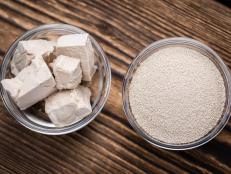Why Are My Cookies Flat? How to Prevent Spreading
Here's how to stop your cookies from spreading.

ZenShui/Laurence Mouton/Getty Images
By Heath Goldman for Food Network Kitchen
There’s nothing worse than baking off fresh cookies, anticipating perfectly fluffy results, only to have them turn out flat-as-pancakes. Yep, you can still eat them, but they’re not what you were expecting. What went wrong? Below, we’ve rounded up some of the most common reasons why cookies spread too much.

SouthernLightStudios/Getty Images
The Problem: The Butter Is Too Soft
Many cookie recipes call for "softened" butter, which sounds like a pretty vague term that’s open to interpretation. In actuality, softened butter is a very specific baking descriptor: the butter should be left out at room temperature for thirty minutes to one hour until it’s pliable but still cool to the touch. You should be able to indent it with a finger and your fingerprint should look like a clean divot. Room temperature butter is just the right consistency to incorporate air when it’s creamed with sugar. These trapped air pockets result in risen, fluffy cookies. If the butter is any warmer, it won’t incorporate enough air and your cookies will have less rise. Moreover, butter that’s warmer than room temperature melts in an instant in the oven, encouraging the dough to spread quickly with it.
The Fix: Chilling the Dough
Refrigerate the remaining dough until it feels firm to the touch, one to two hours. This chills the butter, so it won’t spread rapidly in the oven. Although your cookies won’t be as fluffy as they might have been, they won’t turn into pancakes.

Tetra Images/Getty Images
The Problem: You’re Baking on Hot Baking Sheets
You’re in a groove making cookies, and after the first batch comes out, you transfer a new batch of dough to the baking sheet. While the first batch came out perfectly, the second batch spread a lot, perhaps so much that the cookies fused together. What happened? It all comes back to that butter, people. Hot baking sheets cause the butter to melt really quickly, bringing the dough with it.
The Fix: Cooling the Baking Sheets Under Running Water
We get that you might have a limited number of baking sheets and amount of time. But you really want to make sure your baking sheets are completely cool between batches. Luckily, there’s a trick for that. Let your baking sheets cool a few minutes so they’re warm, not screaming hot. Then rinse them off under room temperature water until they’re no longer hot to the touch. Dry them off and place your cookies on the magically cool sheets.
The Problem: Your Oven Is Too Hot
If your cookies repeatedly turn out flat, no matter the recipe, chances are your oven is too hot. Here’s what’s happening. The butter melts super quickly in a too-hot oven before the other ingredients have firmed up into a cookie structure. Therefore, as the butter spreads so does the whole liquidy cookie.
The Fix: Adjust the Temperature
An immediate fix is to lower your oven by a few degrees and extend the baking time. In the long-term, consider buying an oven thermometer and leaving it in your oven so you know your oven’s exact temperature. Then you can adjust the heat accordingly, or, better yet, consult the manual on how to calibrate the oven.

Debby Lewis-Harrison/Getty Images
The Problem: Incorrectly Measured Ingredients
If your ratios of flour, butter and sugar off, the cookie might spread too quickly. This can occur if you aren’t precise with your measurements. If your recipe calls for 1 cup of sugar, for example, and you add a slightly heaping cup instead of leveling off the cup precisely, you’ll end up with too much. Sugar sucks up liquid, and when those cookies bake, it’ll release the liquid and cause the cookies to spread out. If you use too much butter, the cookies will end up flat and greasy. And if you use too little flour, the amount of butter and sugar will be proportionally too high, meaning the cookies will spread for the aforementioned reasons.
The Fix: Bulk It Up a Little
If you realize that you used too little flour, simply stir a couple more tablespoons into the batter. Otherwise, shape your cookies and freeze them on the baking sheet until they’re solid. Although the cookies might still spread some, the frozen butter will counteract the action. If all else fails, consider repurposing your flattened cookies: crumble them up as ice cream toppings or mix-ins, or stir them into cake batter or nut butter for a decadent treat.
Related Links:































































